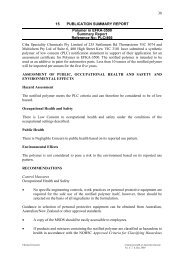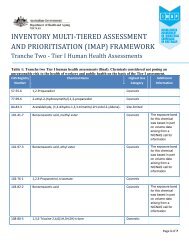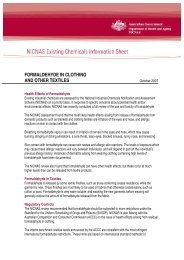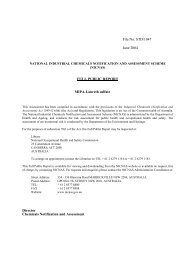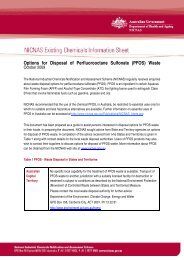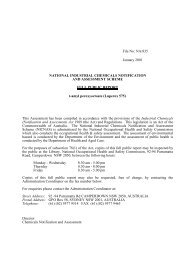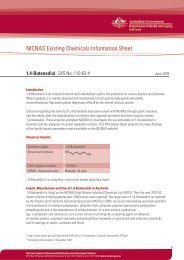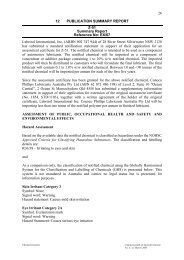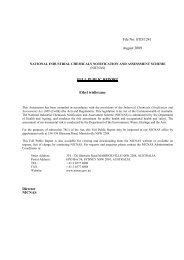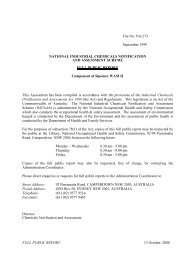Component of Basazol Violet 46 L - NICNAS
Component of Basazol Violet 46 L - NICNAS
Component of Basazol Violet 46 L - NICNAS
You also want an ePaper? Increase the reach of your titles
YUMPU automatically turns print PDFs into web optimized ePapers that Google loves.
File No: NA/538<br />
July 1999<br />
NATIONAL INDUSTRIAL CHEMICALS NOTIFICATION<br />
AND ASSESSMENT SCHEME<br />
FULL PUBLIC REPORT<br />
<strong>Component</strong> <strong>of</strong> <strong>Basazol</strong> <strong>Violet</strong> <strong>46</strong> L<br />
This Assessment has been compiled in accordance with the provisions <strong>of</strong> the Industrial<br />
Chemicals (Notification and Assessment) Act 1989 (the Act) and Regulations. This legislation<br />
is an Act <strong>of</strong> the Commonwealth <strong>of</strong> Australia. The National Industrial Chemicals Notification<br />
and Assessment Scheme (<strong>NICNAS</strong>) is administered by the National Occupational Health and<br />
Safety Commission which also conducts the occupational health & safety assessment. The<br />
assessment <strong>of</strong> environmental hazard is conducted by the Department <strong>of</strong> the Environment and<br />
the assessment <strong>of</strong> public health is conducted by the Department <strong>of</strong> Health and Aged Care.<br />
For the purposes <strong>of</strong> subsection 78(1) <strong>of</strong> the Act, copies <strong>of</strong> this full public report may be<br />
inspected by the public at the Library, National Occupational Health and Safety Commission,<br />
92-94 Parramatta Road, Camperdown NSW 2050, between the following hours:<br />
Monday - Wednesday 8.30 am - 5.00 pm<br />
Thursday 8.30 am - 8.00 pm<br />
Friday 8.30 am - 5.00 pm<br />
Copies <strong>of</strong> this full public report may also be requested, free <strong>of</strong> charge, by contacting the<br />
Administration Coordinator on the fax number below.<br />
For enquiries please contact the Administration Coordinator at:<br />
Street Address: 92 Parramatta Rd Camperdown, NSW 2050, AUSTRALIA<br />
Postal Address: GPO Box 58, Sydney 2001, AUSTRALIA<br />
Telephone: (61) (02) 9577-9514 FAX (61) (02) 9577-9<strong>46</strong>5<br />
Director<br />
Chemicals Notification and Assessment
1. APPLICANT<br />
FULL PUBLIC REPORT<br />
<strong>Component</strong> <strong>of</strong> <strong>Basazol</strong> <strong>Violet</strong> <strong>46</strong> L<br />
NA/538<br />
BASF Australia Ltd <strong>of</strong> 500 Princes Highway NOBLE PARK 3174 has submitted a standard<br />
notification statement in support <strong>of</strong> their application for an assessment certificate for<br />
<strong>Component</strong> <strong>of</strong> <strong>Basazol</strong> <strong>Violet</strong> <strong>46</strong> L.<br />
2. IDENTITY OF THE CHEMICAL<br />
The following requests for exempt information were accepted: chemical name, CAS No.,<br />
molecular and structural formulae, concentration level in the imported product, spectral data<br />
and formulation details.<br />
Molecular Weight: 515<br />
Spectral Data: spectral data were not provided as the notified chemical<br />
is synthesised as a component <strong>of</strong> a mixture; however,<br />
ultraviolet/visible spectra for chemically similar<br />
substances were provided<br />
Method <strong>of</strong> Detection<br />
and Determination: infrared spectroscopy<br />
3. PHYSICAL AND CHEMICAL PROPERTIES<br />
Little data exist for the notified chemical itself. Information was provided for the imported<br />
product or a similar substance, crystal violet chloride (CAS No. 548-62-9), which is<br />
chemically similar to the notified chemical.<br />
Appearance at 20°C<br />
and 101.3 kPa: the imported solution is a dark violet liquid<br />
Melting Point: the melting point <strong>of</strong> crystal violet chloride is 195 -<br />
198°C<br />
2
Density: approximately 1 080 kg/m 3 at 20°C; the density <strong>of</strong><br />
crystal violet chloride is 1 190 kg/m 3<br />
Vapour Pressure: not determined<br />
Water Solubility: miscible in all proportions at room temperature; the<br />
water solubility <strong>of</strong> crystal violet chloride is 10 g/L at<br />
20°C<br />
Partition Co-efficient<br />
(n-octanol/water): log P ow for crystal violet chloride is 1.39<br />
Hydrolysis as a Function<br />
<strong>of</strong> pH: not determined<br />
Adsorption/Desorption: not determined<br />
Dissociation Constant: not determined<br />
Particle Size: not applicable as the notified chemical is in liquid form<br />
Flash Point: > 100°C (imported product)<br />
Flammability Limits: not determined<br />
Autoignition Temperature: > 200°C (imported product)<br />
Explosive Properties: not explosive based on structure<br />
Reactivity/Stability: not considered reactive<br />
Comments on Physico-Chemical Properties<br />
The notifier did not submit any data regarding vapour pressure as the notified chemical is<br />
ionic in nature, and hence the vapour pressure is expected to be low.<br />
The water solubility <strong>of</strong> the chemically similar substance Crystal <strong>Violet</strong> Chloride has been<br />
determined, and given as 10 g/L at 20°C in the Material Safety Data Sheet (MSDS).<br />
The chemical doesn’t contain any functionalities which would be expected to undergo<br />
hydrolysis under the usual environmental pH range between 4 and 9.<br />
Since the substance is <strong>of</strong> high water solubility, the partition coefficient (value supplied also<br />
based on the substance Crystal <strong>Violet</strong> Chloride and taken from the literature (Tonogai et al.,<br />
1982)) and adsorption/desorption will be relatively low. However, the chemical contains a<br />
3
charged centre which will be attracted to the colloidal material in the aquatic compartment<br />
which is usually negatively charged.<br />
No dissociation data were provided. However, the compound contains aromatic amino<br />
groups, which are normally <strong>of</strong> low basicity, eg pK a for N,N-diethylanaline is 6.61. However,<br />
in the present compound the potential for protonation <strong>of</strong> the amino groups will be further<br />
reduced due to the delocalised positive charge on the aromatic centres. Consequently, the<br />
new compound is likely to be protonated only in low pH environments.<br />
4. PURITY OF THE CHEMICAL<br />
Degree <strong>of</strong> Purity: > 99%<br />
Toxic or Hazardous<br />
Impurities: none<br />
Non-hazardous Impurities<br />
(> 1% by weight): none<br />
Additives/Adjuvants: none<br />
5. USE, VOLUME AND FORMULATION<br />
The notified chemical is to be imported at a level <strong>of</strong> l0 -< 30% (see Material Safety Data<br />
Sheet (MSDS) – the product contains 2 dyes, accounting for the figure <strong>of</strong> 30 - < 60%) in a<br />
dye formulation containing acetic acid, solvent and water. The chemical is a dye used in the<br />
manufacturing industry as a colouring agent for moulded objects such as fruit trays. It is<br />
estimated that the fruit trays will contain 0.1% notified chemical. The notified chemical will<br />
be imported at a rate <strong>of</strong> approximately 2.5 tonnes per year for the first five years in 1 000 L<br />
Schuetz type containers.<br />
6. OCCUPATIONAL EXPOSURE<br />
The dye formulation containing the notified chemical will be imported in 1 000 L Schuetz<br />
containers approximately 12 times per year. It is estimated that approximately 7 workers<br />
will handle the containers for a maximum 3 hours per year. Transport and storage should not<br />
result in exposure except in the event <strong>of</strong> accidental spillage. The notifier states that the<br />
imported product may be sampled by the laboratory with 3 analysts handling 200 mL<br />
samples for approximately 6 hours per year.<br />
Following transport to a single customer site, 4 plant operators will be involved in the paper<br />
dyeing process for approximately 3 hours per year. The dyeing process takes place in a<br />
closed system and the notifier states that the product is only handled when the end <strong>of</strong> the dye<br />
line to the outlet valve <strong>of</strong> a new Schuetz tank is connected once per month. The notifier<br />
estimates that a maximum <strong>of</strong> 20 mL <strong>of</strong> the product may be spilt during each connection and<br />
4
may potentially lead to dermal exposure. The notifier states that personal protective<br />
equipment (overalls, gloves, chemical face shields and goggles) are made available to operators<br />
although the actual protection to be worn during each operation was not stated. Local exhaust<br />
ventilation is installed in areas <strong>of</strong> the workplace where natural ventilation is inadequate.<br />
The paper dyeing process does not involve workers with any direct contact with the dye<br />
solution. The dye solution is pumped directly from the Schuetz tank into a suspension <strong>of</strong><br />
newsprint/magazine fibre suspension (1% solids) in water. The dye is exhausted on to the<br />
fibre by the time it reaches the headbox <strong>of</strong> the machine, after which forming occurs. From the<br />
headbox, the dyed stock is introduced onto a porous rotating drum fashioned with fruit tray<br />
moulds on its outer surface. On the drum, a fibre mat forms which is transferred to a<br />
continuous tray. From the drum the formed trays pass through a drying section where they<br />
emerge as finished trays . Once the trays are dried, the dye is fixed to the fibre and the<br />
notified chemical is not bioavailable.<br />
7. PUBLIC EXPOSURE<br />
The notified chemical is for industrial use only as a colouring agent. The potential for public<br />
exposure during transport, production <strong>of</strong> food packaging products or from disposal is<br />
assessed as negligible. Members <strong>of</strong> the public will make dermal contact with food packaging<br />
products (such as fruit trays), however exposure will be low because <strong>of</strong> the low concentration<br />
<strong>of</strong> the notified chemical in these products (0.1%) and its low leachability from the dyed<br />
products.<br />
8. ENVIRONMENTAL EXPOSURE<br />
Release<br />
During production <strong>of</strong> the moulded paper products the newsprint/magazine is “slushed” with<br />
water in a pulper to form a thickstock. The thickstock is diluted to a 1% solids fibre<br />
suspension with recycled process water and the dyeing process takes place simultaneously.<br />
The dyed stock is introduced onto a porous rotating drum fashioned with fruit tray moulds<br />
on its outer surface. The water drained from the dyed pulp is recycled again and reused to<br />
dilute incoming thickstock. A fibre mat is formed and transferred to a continuous tray. The<br />
finished trays pass through a drying section with an estimated moisture content <strong>of</strong> 8-12 %.<br />
The dyeing process takes place in a closed system with continuous water recycle. The<br />
connection <strong>of</strong> the dye line to a new Schuetz tank occurs once a month and a maximum <strong>of</strong><br />
20 mL <strong>of</strong> product may be spilt during each connection.<br />
Release from the dyehouse into the wastewater system is estimated by the notifier to be 20<br />
kg <strong>of</strong> the notified chemical per annum. This will be predominantly sorbed to the high content<br />
<strong>of</strong> solids in the effluent (see below). This figure presumably also includes the spillage amount<br />
that occurs in changing dye lines to a new tank.<br />
5
Residual dyestuff may remain in the packaging after use. It is estimated that less than 10 L <strong>of</strong><br />
the product (ie. 2 L <strong>of</strong> the notified chemical) will be retained. Given a maximum import <strong>of</strong> 10<br />
tonnes in 10 packages, a total <strong>of</strong> less than 100 kg <strong>of</strong> the dyestuff (ie. 20 kg <strong>of</strong> the new<br />
chemical) will be retained in the packaging. The packaging and residue will be disposed to an<br />
incinerator or landfill.<br />
Fate<br />
The bulk <strong>of</strong> the dye will become chemically fixed to the paper fibres and a low percentage <strong>of</strong><br />
the chemical will be discharged to the sewer, where it may remain in colloidal suspension or<br />
be removed with sludge during treatment. The fate <strong>of</strong> the majority <strong>of</strong> the notified substance is<br />
linked with the fate <strong>of</strong> the particular item and in this state is not expected to impact on the<br />
environment. Paper based products containing the new dye would be disposed <strong>of</strong> into<br />
landfill, incinerated or possibly recycled. During recycling activities the dye would become<br />
associated with the fibrous material in the waste sludge which is likely to be either placed into<br />
landfill or incinerated. In a landfill the paper and dye are expected to be slowly degraded<br />
through biological processes, and the dye would decompose to water, and oxides <strong>of</strong> carbon<br />
and nitrogen. Incineration would also destroy the dye, with evolution <strong>of</strong> water vapour and<br />
oxides <strong>of</strong> carbon and nitrogen.<br />
In the event <strong>of</strong> accidental spillage <strong>of</strong> the dyestuff into waterways, the chemical is not<br />
expected to disperse into the water, but settle out onto sediments after adsorbing to the<br />
organic fraction. If the dyestuff is spilt on land, either during usage or transport, it is<br />
expected that the chemical would become immobilised in the soil layer. Contaminated soil can<br />
then be collected and disposed to landfill.<br />
Biodegradation/Bioaccumulation<br />
The notifier provided no direct evidence to indicate that the new chemical is biodegradable.<br />
However, data on similar products that contain the dyestuffs Basic <strong>Violet</strong> 1 and Basic <strong>Violet</strong><br />
3 indicate that the biodegradability <strong>of</strong> such products is 50-100 %. This percentage range is<br />
based on MSDS information only and the notifier did not provide any units or time length<br />
with these figures.<br />
The high claimed level <strong>of</strong> biodegradability and the low log Pow <strong>of</strong> 1.39 would suggest little<br />
potential for bioaccumulation. Furthermore, low exposure and adsorption to sediment in the<br />
sewage treatment <strong>of</strong> waste from the dyehouse would reduce the quantity <strong>of</strong> notified<br />
substance eventually released to the aquatic environment and limit the bioaccumulation<br />
potential.<br />
9. EVALUATION OF TOXICOLOGICAL DATA<br />
No toxicological data were provided for the notified chemical. The acute oral toxicity, skin<br />
and eye irritation studies were performed using the product to be imported, <strong>Basazol</strong> <strong>Violet</strong> <strong>46</strong><br />
L. The bacterial mutagenicity and chromosome damage studies were conducted using ethyl<br />
6
violet chloride, an analogue <strong>of</strong> the notified chemical. In the absence <strong>of</strong> specific data, the toxic<br />
endpoints obtained are assumed to be applicable to the notified chemical.<br />
9.1 Acute Toxicity<br />
Summary <strong>of</strong> the acute toxicity <strong>of</strong> <strong>Basazol</strong> <strong>Violet</strong> <strong>46</strong> L (21% notified chemical)<br />
Test Species Outcome Reference<br />
acute oral toxicity rat LD 50 = 620 mg/kg<br />
(males), 420 mg/kg<br />
(females), 510 mg/kg<br />
(combined)<br />
(Kirsch &<br />
Kersebohm,<br />
1988)<br />
skin irritation rabbit not irritant (Kirsch &<br />
Gamer, 1988a)<br />
eye irritation rabbit severe irritant (Kirsch &<br />
Gamer, 1988b)<br />
9.1.1 Oral Toxicity (Kirsch & Kersebohm, 1988)<br />
Species/strain: rat/Wistar<br />
Number/sex <strong>of</strong> animals: 5/sex/dose group<br />
Dose groups: 100, 215, <strong>46</strong>4, 825 or 2 000 mg/kg<br />
Observation period: 21 days<br />
Method <strong>of</strong> administration: oral gavage, chemical in distilled water<br />
7
Clinical observations:<br />
none at 100 mg/kg; clinical observations were noted<br />
at the other doses as follows:<br />
Males<br />
Symptom<br />
Dyspnea<br />
Apathy<br />
Staggering<br />
Spastic Gait<br />
Faeces – Blue-<br />
<strong>Violet</strong><br />
Urine – Blue-<br />
<strong>Violet</strong><br />
Piloerection<br />
Diarrhea<br />
Exsiccosis<br />
Poor General<br />
State<br />
Dose<br />
(mg/kg): 2 000 825 <strong>46</strong>4 215<br />
3-6D*<br />
“<br />
“<br />
“<br />
“<br />
4H-<br />
6D<br />
4H-<br />
6D<br />
4H-<br />
5D<br />
3-6D<br />
3-6D<br />
• H = hour, D = day<br />
1-9D<br />
1-9D<br />
2-9D<br />
2-9D<br />
4H-<br />
7D<br />
1-7D<br />
8-16D<br />
7D<br />
1-9D<br />
1-6D<br />
1-6D<br />
4H-<br />
5D<br />
4H-<br />
5D<br />
1-6D<br />
1H-<br />
1D<br />
1H-<br />
1D<br />
4H-<br />
1D<br />
4H-<br />
4D<br />
1H-<br />
6D<br />
1H-<br />
1D<br />
Females<br />
Dose<br />
(mg/kg): 2 000 825 <strong>46</strong>4 215<br />
Symptom<br />
Dyspnea<br />
Apathy<br />
Abnormal Posn<br />
Staggering<br />
Paresis<br />
Spastic Gait<br />
Faeces – Blue-<br />
<strong>Violet</strong><br />
Urine – Blue-<br />
<strong>Violet</strong><br />
Piloerection<br />
Diarrhea<br />
Exsiccosis<br />
Impaired General<br />
State<br />
Poor General<br />
State<br />
* H = hour, D = day<br />
3-7D*<br />
3-7D<br />
3D<br />
3-7D<br />
3D<br />
3-7D<br />
4H-<br />
7D<br />
4H-<br />
7D<br />
4H-<br />
5D<br />
3D<br />
3-7D<br />
1-16D<br />
1-15D<br />
2-15D<br />
2-15D<br />
1H-<br />
7D<br />
4H-<br />
7D<br />
8-21D<br />
1-5H<br />
7D<br />
16D<br />
1-15D<br />
1-16D<br />
1-8D<br />
2-8D<br />
2-8D<br />
1H-<br />
7D<br />
4H-<br />
7D<br />
8-16D<br />
1H-<br />
5H<br />
7D<br />
16D<br />
1-8D<br />
4H-<br />
1D<br />
4H-<br />
1D<br />
4H-<br />
4D<br />
1H-<br />
5D<br />
4H-<br />
1D<br />
8
Mortality: 2 000 mg/kg: all animals; 825 mg/kg: 3/sex;<br />
<strong>46</strong>4 mg/kg: 2 males, 4 females; 215 mg/kg: 0 males,<br />
1 female; 100 mg/kg: no animals<br />
Morphological findings: in animals that died: general congestion; mucosa <strong>of</strong><br />
the stomach/intestines discoloured by the test<br />
substance; liver/musculature/skin: discoloured by<br />
the test substance<br />
Test method: similar to OECD guidelines<br />
LD 50: 620 mg/kg (males); 420 mg/kg (females); 510 mg/kg<br />
(combined)<br />
Result: the notified chemical was <strong>of</strong> low acute oral toxicity<br />
in rats<br />
9.1.2 Dermal Toxicity<br />
Data not provided.<br />
9.1.3 Inhalation Toxicity<br />
Data not provided.<br />
9.1.4 Skin Irritation (Kirsch & Gamer, 1988a)<br />
Species/strain: Rabbit/White Vienna<br />
Number/sex <strong>of</strong> animals: 2 males, 1 female<br />
Observation period: 8 days; readings at 4 hours, 1, 2, 3 and 8 days<br />
Method <strong>of</strong> administration: 0.5 mL <strong>of</strong> the test substance under a semi-occlusive<br />
dressing<br />
Test method: OECD TG404<br />
Result: the notified chemical was not a skin irritant in<br />
rabbits under the conditions <strong>of</strong> the test; however,<br />
due to staining readings <strong>of</strong> erythema could not be<br />
made up to 48 hours after dressing removal and in 2<br />
9
9.1.5 Eye Irritation (Kirsch & Gamer, 1988b)<br />
Species/strain: rabbit/White Vienna<br />
Number/sex <strong>of</strong> animals: 1 male<br />
Observation period: 72 hours<br />
<strong>of</strong> 3 animals at 72 hours and 8 days; the remaining<br />
animal at 72 hours and 8 days did not exhibit<br />
erythema; no oedema was observed at any time<br />
point<br />
Method <strong>of</strong> administration: 0.1 mL <strong>of</strong> the test substance to the conjunctival sac<br />
<strong>of</strong> the right eye<br />
Test method: OECD TG405<br />
Result: the notified chemical was a severe eye irritant in<br />
rabbits; although corneal and iridal effects and<br />
conjunctival redness could not be scored at either 1,<br />
24, 48 or 72 hours post-instillation due to<br />
discolouration, chemosis was well-defined at 1 hour<br />
and very severe at the other time points; discharge<br />
was clearly increased up to 24 hours and distinctly<br />
increased thereafter; the study was terminated at 72<br />
hours because <strong>of</strong> severe irritation<br />
9.1.6 Skin Sensitisation<br />
Data not provided.<br />
9.2 Repeated Dose Toxicity<br />
Data not provided.<br />
9.3 Genotoxicity<br />
9.3.1 Salmonella typhimurium Reverse Mutation Assay with ethyl violet chloride<br />
(H<strong>of</strong>fmann & Engelhardt, 1995b)<br />
Strains: TA 1535, TA 1537, TA 98 and TA 100<br />
Concentration range: 5 μg/plate – 1 000 μg/plate (plate test)<br />
5 μg/plate – 80 μg/plate (preincubation test)<br />
10
Test method: OECD TG471; metabolic activation was provided<br />
by the liver S9 fraction from Aroclor 1254-induced<br />
rats<br />
Result: the background mutation frequency was within the<br />
historical limits for the strains used and the<br />
positive control substances demonstrated the<br />
sensitivity <strong>of</strong> the test<br />
no chemical-induced increase in mutation frequency<br />
was observed in any strain in the absence or<br />
presence <strong>of</strong> metabolic activation provided by rat<br />
liver S9 fraction; however, toxicity was observed<br />
from approximately 5 μg/plate in the preincubation<br />
test and 80 μg/plate in the standard plate test;<br />
therefore, a mutagenic potency <strong>of</strong> less than<br />
approximately 1 mutant/μg may not have been<br />
detected<br />
9.3.2 Chromosomal Aberration Assay in Chinese Hamster V79 Cells (H<strong>of</strong>fmann &<br />
Engelhardt, 1995a)<br />
Cell line: Chinese Hamster V79 cells<br />
Treatment time, Harvest time<br />
and Doses:<br />
Test method: OECD TG473<br />
cells were treated for 4 hours and chromosomes<br />
were prepared after either 18 hours (low, mid and<br />
high doses) or 28 hours (high dose only) <strong>of</strong><br />
incubation; metabolic activation was provided by<br />
the liver S9 fraction from Aroclor 1254-induced<br />
rats<br />
on the basis <strong>of</strong> preliminary cytotoxicity<br />
experiments, the low, mid and high doses,<br />
respectively, were 0.4, 0.6 or 0.8 μg/mL without<br />
S9 and 2, 4 or 6 μg/mL with S9<br />
Result: the negative controls gave background chromosomal<br />
aberration frequencies with the range expected for<br />
V79 cells and the positive control chemicals gave<br />
the expected increases<br />
in the first <strong>of</strong> 2 experiments a statistically<br />
significant increase in the percentage <strong>of</strong> cells with<br />
11
9.4 Overall Assessment <strong>of</strong> Toxicological Data<br />
structural chromosomal aberrations was observed<br />
with the test chemical at 0.4 μg/mL (P ≤ 0.05,<br />
excluding gaps, without S9); however, as no other<br />
positive results were obtained, this result appears<br />
to be due to chance; on balance ethyl violet chloride<br />
is not clastogenic in either the absence or presence<br />
<strong>of</strong> metabolic activation provided by rat liver S9<br />
fraction<br />
The imported solution containing the notified chemical (<strong>Basazol</strong> <strong>Violet</strong> <strong>46</strong>L) was <strong>of</strong><br />
moderate to low acute oral toxicity in rats (LD 50 = 420 mg/kg, females). The skin irritancy<br />
study in rabbits was inconclusive due to staining <strong>of</strong> the skin. However, the imported<br />
product is likely to be a skin irritant, based on the concentration <strong>of</strong> acetic acid. Similar<br />
staining <strong>of</strong> the eye in rabbits did not obscure eye damage and <strong>Basazol</strong> <strong>Violet</strong> <strong>46</strong>L was a<br />
severe eye irritant. On the basis <strong>of</strong> results with an analogue, ethyl violet chloride, the<br />
notified chemical is probably not genotoxic. The notified chemical is classified as a<br />
hazardous substance according to NOHSC Approved Criteria for Classifying Hazardous<br />
Substances (National Occupational Health and Safety Commission, 1994a) in terms <strong>of</strong> acute<br />
lethal effects and severe eye effects and the risk phrases R 22: harmful if swallowed and R<br />
41: risk <strong>of</strong> serious damage to eyes should be included on the Material Safety Data Sheet<br />
(MSDS) and label for <strong>Basazol</strong> <strong>Violet</strong> <strong>46</strong>L.<br />
Skin sensitisation data were not provided but it is unlikely that a positive response could be<br />
detected due to staining <strong>of</strong> skin by the dye. Acute dermal toxicity and repeated dose toxicity<br />
data were not provided. Therefore, on the basis that <strong>Basazol</strong> <strong>Violet</strong> <strong>46</strong>L exhibited acute oral<br />
toxic effects (low/moderate toxicity) and that the dye discoloured the liver, musculature and<br />
skin following oral administration (i.e. was absorbed from the gut), it is possible that the<br />
notified chemical could be hazardous in terms <strong>of</strong> acute dermal effects and severe effects after<br />
repeated or prolonged exposure.<br />
10. ASSESSMENT OF ENVIRONMENTAL EFFECTS<br />
The following ecotoxicity studies on the imported product have been supplied by the notifier.<br />
The tests were performed in compliance with OECD/EEC Test Methods and according to<br />
OECD Principles <strong>of</strong> Good Laboratory Practices.<br />
Species Test Test concs<br />
(nominal) mg/L<br />
Result<br />
Rainbow trout<br />
(Salmo Gairdneri Rich.)<br />
Acute Toxicity (static)<br />
(OECD TG 203)<br />
> 0.1 0.1< 96 h LC50 < 0.215<br />
mg/L<br />
Activated sludge bacteria Robra test 0.5 h LC50 = 61 mg/L<br />
The tests on rainbow trout were performed using a static test methodology. A stock solution<br />
<strong>of</strong> the test material was made up at a nominal concentration <strong>of</strong> 1 000 mg/L, and this was then<br />
used to prepare five solutions <strong>of</strong> the chemical in water (which had been dechlorinated by<br />
12
filtering through charcoal), with nominal concentrations <strong>of</strong> 0.0<strong>46</strong>4, 0.100, 0.215, 0.<strong>46</strong>4 and 1.0<br />
mg/L. The tests were conducted over a 96-hour period at a controlled temperature <strong>of</strong> 12 ±<br />
1 o C.<br />
Ten fish were tested at each concentration, and during these tests the pH <strong>of</strong> the test solutions<br />
was always between 7.0 and 7.9, while dissolved oxygen levels were always between 7.1 and<br />
9.8 mg/L. The test results were apparently analysed using probit analysis (Finney, 1971),<br />
and indicate that the new dye is highly toxic to the rainbow trout, with a 96 hour LC 50<br />
between 0.1 and 0.215 mg/L (99% confidence). In fact, after 96 hours exposure to a nominal<br />
concentration <strong>of</strong> 0.1 mg/L no fish mortality had occurred, but after exposure to a nominal<br />
0.215 mg/L, all had died. The only sub-lethal effect indicated in the report was general apathy<br />
within the fish population.<br />
No other reports on ecotoxicity were submitted, although the MSDS indicated that a test on<br />
the inhibition <strong>of</strong> respiration <strong>of</strong> activated sludge bacteria had been conducted (the Robra test),<br />
which indicated the chemical to be mildly toxic to these bacteria.<br />
The notifier has not provided any ecotoxicological data for daphnia species or algae, largely on<br />
the basis <strong>of</strong> the anticipated low environmental exposure.<br />
It is noted that the new chemical is highly toxic to fish, and is assumed to be also toxic to<br />
daphnia and algae (Nabholz et al. 1993). This lack <strong>of</strong> data is only acceptable because <strong>of</strong> the<br />
expected strong binding to suspended solids <strong>of</strong> the charged species predominating in the<br />
aquatic environment and to the low expected exposure to the water compartment.<br />
11. ASSESSMENT OF ENVIRONMENTAL HAZARD<br />
Based on a maximum annual import <strong>of</strong> 10 tonnes <strong>of</strong> the product (ie. 2 tonnes <strong>of</strong> notified<br />
chemical) the notifier estimates that up to 1 % (20 kg) <strong>of</strong> the chemical will be required to be<br />
processed through the wastewater treatment plant per annum. The notifier notes that the<br />
discharge rate by the dyehouse to the sewer is 2 L/s and estimates this would have a<br />
maximum <strong>of</strong> 0.15% <strong>of</strong> the dye fixed to the suspended solid fraction. Though the notifier has<br />
not provided any information to enable the fixation percentage to be determined, it is accepted<br />
that the majority <strong>of</strong> the released dye will be associated with the suspended solids <strong>of</strong> the paper<br />
fibre.<br />
The environmental hazard from the dye, when fixed to paper products such as newsprint and<br />
magazines is rated as negligible, with the dye sharing the fate <strong>of</strong> the paper products. The<br />
most significant environmental exposure would be from the release <strong>of</strong> the dye in the<br />
wastestream from dyehouse to the aquatic compartment. The Predicted Environmental<br />
Concentration (PEC) in the dye house effluent is estimated below.<br />
13
Calculation Factor Dyehouse (per annum)<br />
Amount <strong>of</strong> notified chemical used 2 tonnes<br />
Release per annum 20 kg (1 % total usage)<br />
Effluent Flow 200,000 L/day x 365 days = 63,072,000 L/yr<br />
PEC in sewer (Mean concentration in<br />
effluent)<br />
20 x 10 6 mg/63,072,000 L/yr ≅ 0.32 mg/L<br />
These calculations assume the worst case scenario for the dyehouse ie. that all the chemical<br />
released is in the dissolved state. The calculations show that the exposure to fish and<br />
presumably daphnia, algae and wastewater treatment bacteria is at levels likely to cause a<br />
significant effect. However, the new chemical will carry a positive charge distributed over a<br />
system <strong>of</strong> aromatic rings, and consequently is likely to have a strong affinity for particulate<br />
and colloidal matter, which are usually negatively charged in the environment. Therefore,<br />
little <strong>of</strong> the chemical is likely to remain in a truly dissolved state, and association with<br />
particulate material would mitigate potential toxic effects.<br />
The fate <strong>of</strong> the majority <strong>of</strong> the notified substance is linked with the fate <strong>of</strong> the particular item.<br />
In this particular case, most <strong>of</strong> the dye will become attached to paper fibres that will<br />
ultimately go to landfill or incineration.<br />
In the event <strong>of</strong> accidental spillage <strong>of</strong> the dyestuff into waterways, the chemical is expected to<br />
eventually become associated with the sediments. If the dyestuff is spilt on land, either<br />
during usage or transport, it is expected that the chemical would become immobilised in the<br />
soil layer. Contaminated soil would then be collected and disposed <strong>of</strong> to landfill.<br />
Solid waste consigned to landfill, either from spillage or residues in packaging, would be<br />
expected to be retained at the landfill sites and not be mobile. Movement <strong>of</strong> the chemical by<br />
leaching from landfill sites is not expected because <strong>of</strong> its high binding affinity to soil.<br />
Given the above, environmental exposure and the overall environmental hazard is expected to<br />
be acceptable.<br />
12. ASSESSMENT OF PUBLIC AND OCCUPATIONAL HEALTH AND SAFETY<br />
EFFECTS<br />
On the basis <strong>of</strong> the toxicological data submitted for the imported product, the notified<br />
chemical is likely to exhibit moderate to low acute oral toxicity. Skin irritation potential is<br />
uncertain given the staining <strong>of</strong> rabbit skin during the skin irritancy study. For this reason it is<br />
likely that a test for skin sensitisation potential would also be inconclusive. The product is a<br />
severe eye irritant in rabbits. Although it is likely the irritancy is due, at least in part, to<br />
acetic acid contained in the formulation, in the absence <strong>of</strong> a test using the notified chemical<br />
alone, it must be assumed that the chemical is hazardous according to NOHSC Approved<br />
Criteria for Classifying Hazardous Substances (National Occupational Health and Safety<br />
Commission, 1994a) on the basis <strong>of</strong> severe eye damage and acute oral effects. The risk<br />
14
phrases R 22: harmful if swallowed and R 41: risk <strong>of</strong> serious damage to eyes should be<br />
included on the Material Safety Data Sheet (MSDS) and label for <strong>Basazol</strong> <strong>Violet</strong> <strong>46</strong>L. It is<br />
also reasonable to assume the chemical is a skin irritant.<br />
An analogue <strong>of</strong> the notified chemical, ethyl violet chloride is not genotoxic as judged by tests<br />
for bacterial mutagenicity and chromosomal damage in Chinese Hamster V79 cells. Therefore,<br />
the notified chemical also may not exhibit genotoxic effects in vitro.<br />
As the notified chemical exhibits acute toxic effects via the oral route and appears to be<br />
readily absorbed from the gut, it is possible that the notified chemical is a hazardous<br />
substance in terms <strong>of</strong> acute dermal effects and severe effects after repeated or prolonged<br />
exposure.<br />
Occupational Health and Safety<br />
The risk <strong>of</strong> adverse health effects resulting from exposure to the notified chemical during<br />
transport and storage <strong>of</strong> the 1 000 L Schuetz tanks in which it is imported is low as exposure<br />
is unlikely except in the event <strong>of</strong> accidental spillage.<br />
Exposure <strong>of</strong> plant operators and quality control personnel is limited to 12 times per year<br />
when a new Schuetz tank containing the notified chemical is connected to a closed system in<br />
which the notified dye is exhausted on to paper fibre. The notifier estimates that<br />
approximately 20 mL <strong>of</strong> dye solution may be spilt on each <strong>of</strong> the 12 occasions and states that<br />
overalls, gloves, chemical face shields and goggles are made available for workers to wear<br />
during connection and disconnection operations.<br />
The most likely adverse health effect from use or disposal <strong>of</strong> the notified chemical is skin or<br />
eye irritation (severe) in plant operators or quality control personnel. Infrequent exposure is<br />
likely to limit severe effects following repeated or prolonged use or acute dermal effects.<br />
Once the dye is fixed to the fibre, the risk <strong>of</strong> adverse health effects is negligible as the notified<br />
chemical is bound to the matrix. It is likely to be no longer bioavailable, however fixation data<br />
were not provided by the notifier.<br />
Acetic acid is present in the imported formulation at a concentration above the cut-<strong>of</strong>f for<br />
irritancy and corrosivity according to NOHSC List <strong>of</strong> Designated Hazardous Substances<br />
(National Occupational Health and Safety Commission, 1997) endorsed by the National<br />
Commission. Therefore, the risk phrase R 34: causes burns should be included on MSDS and<br />
labels. Employers are responsible for ensuring that the NOHSC exposure standard <strong>of</strong><br />
25 mg/m 3 (TWA) and 37 mg/m 3 (STEL) is not exceeded in the workplace.<br />
Public Health<br />
The risk <strong>of</strong> adverse public health effects resulting from transport, storage, use or disposal <strong>of</strong><br />
the notified chemical is minimal. Although the public will come into contact with food<br />
packaging products containing the notified chemical the public health risk is minimal given its<br />
low level (0.1%) in these products and low leachability from the products.<br />
15
13. MATERIAL SAFETY DATA SHEET<br />
The MSDS for the imported formulation containing the notified chemical was provided in<br />
accordance with the National Code <strong>of</strong> Practice for the Preparation <strong>of</strong> Material Safety Data<br />
Sheets (National Occupational Health and Safety Commission, 1994b).<br />
This MSDS was provided by the applicant as part <strong>of</strong> the notification statement. It is<br />
reproduced here as a matter <strong>of</strong> public record. The accuracy <strong>of</strong> this information remains the<br />
responsibility <strong>of</strong> the applicant.<br />
14. RECOMMENDATIONS<br />
To minimise occupational exposure to the notified chemical the following guidelines and<br />
precautions should be observed:<br />
• Safety goggles should be selected and fitted in accordance with Australian Standard<br />
(AS) 1336 (Standards Australia, 1994) to comply with Australian/New Zealand<br />
Standard (AS/NZS) 1337 (Standards Australia/Standards New Zealand, 1992);<br />
• Industrial clothing should conform to the specifications detailed in AS 2919<br />
(Standards Australia, 1987);<br />
• Impermeable gloves should conform to AS/NZS 2161.2<br />
(Standards Australia/Standards New Zealand, 1998);<br />
• All occupational footwear should conform to AS/NZS 2210<br />
(Standards Australia/Standards New Zealand, 1994);<br />
• Spillage <strong>of</strong> the notified chemical should be avoided. Spillage should be cleaned up<br />
promptly with absorbents which should then be put into containers for disposal;<br />
• Good personal hygiene should be practised to minimise the potential for ingestion;<br />
• A copy <strong>of</strong> the MSDS should be easily accessible to employees.<br />
15. REQUIREMENTS FOR SECONDARY NOTIFICATION<br />
Secondary notification <strong>of</strong> the notified chemical will be required under subsection 64(1) <strong>of</strong> the<br />
Act should the import volume be greater than 2.5 tonnes per annum or the concentration <strong>of</strong><br />
the notified chemical in an imported formulation exceed 25% (w/v).<br />
Secondary notification under subsection 64(2) shall be required if any <strong>of</strong> the circumstances<br />
stipulated in this subsection arise.<br />
16
16. REFERENCES<br />
Finney DJ (1991) Probit Analysis. Cambridge University Press.<br />
H<strong>of</strong>fmann HD & Engelhardt G (1995a) In vitro Chromosome Aberration Assay with<br />
Ethylviolett Chlorid in V79 Cells, Project No. 32M0284/944327, BASF Department <strong>of</strong><br />
Toxicology, Ludwigshafen, Germany.<br />
H<strong>of</strong>fmann HD & Engelhardt G (1995b) Report on the Study <strong>of</strong> Ethylviolett-Chlorid in the<br />
Ames Test, Project No. 40M0284/944330, BASF Department <strong>of</strong> Toxicology, Ludwigshafen,<br />
Germany.<br />
Kirsch P & Gamer AO (1988a) Report on the Acute Dermal Irritation/Corrosivity to the<br />
Intact Dorsal Skin <strong>of</strong> the White Rabbit based on OECD Guideline 404; Test Substance:<br />
<strong>Basazol</strong> <strong>Violet</strong> <strong>46</strong>L, Project No. 18H0217/882151, BASF Aktiengesellschaft,<br />
Ludwigshafen/Rhein, Germany.<br />
Kirsch P & Gamer AO (1988b) Report on the Acute Irritation to the Eye <strong>of</strong> the White<br />
Rabbit; Test Substance: <strong>Basazol</strong> <strong>Violet</strong> <strong>46</strong>L, Project No. 1H0217/882152, BASF<br />
Aktiengesellschaft, Ludwigshafen/Rhein, Germany.<br />
Kirsch P & Kersebohm B (1988) Report on the Study <strong>of</strong> Acute Oral Toxicity; Test<br />
Substance: <strong>Basazol</strong> <strong>Violet</strong> <strong>46</strong>L, Project No. 10A0217/881104, BASF Aktiengesellschaft,<br />
Ludwigshafen/Rhein, Germany.<br />
Nabholz JV, Miller P & Zeeman M (1993) Environmental Risk Assessment <strong>of</strong> New<br />
Substances under the Toxic Substances Control Act Section Five. In: W. G. Landis, J. S.<br />
Hughes and M. A. Lewis ed. Environmental Toxicology and Risk Assessment, American<br />
Society for Testing and Materials. ASTM STP 1179, Philadelphia, : 40-55.<br />
National Occupational Health and Safety Commission (1994a) Approved Criteria for<br />
Classifying Hazardous Substances [NOHSC:1008(1994)]. Australian Government Publishing<br />
Service, Canberra.<br />
National Occupational Health and Safety Commission (1997) Draft List <strong>of</strong> Designated<br />
Hazardous Substances [NOHSC:10005(1997)].<br />
National Occupational Health and Safety Commission (1994c) National Code <strong>of</strong> Practice for<br />
the Preparation <strong>of</strong> Material Safety Data Sheets [NOHSC:2011(1994)]. Australian<br />
Government Publishing Service, Canberra.<br />
Organisation for Economic Co-operation and Development (1995-1996) OECD Guidelines<br />
for the Testing <strong>of</strong> Chemicals on CD-Rom. OECD, Paris.<br />
17
Standards Australia (1987) Australian Standard 2919-1987, Industrial Clothing. Standards<br />
Association <strong>of</strong> Australia, Sydney.<br />
Standards Australia (1994) Australian Standard 1336-1994, Eye protection in the Industrial<br />
Environment. Standards Association <strong>of</strong> Australia, Sydney.<br />
Standards Australia/Standards New Zealand (1992) Australian/New Zealand Standard 1337-<br />
1992, Eye Protectors for Industrial Applications. Standards Association <strong>of</strong><br />
Australia/Standards Association <strong>of</strong> New Zealand, Sydney/Wellington.<br />
Standards Australia/Standards New Zealand (1994) Australian/New Zealand Standard 2210-<br />
1994, Occupational Protective Footwear. Standards Association <strong>of</strong> Australia/Standards<br />
Association <strong>of</strong> New Zealand, Sydney/Wellington.<br />
Standards Australia/Standards New Zealand (1998) Australian/New Zealand Standard 2161.2-<br />
1998, Occupational protective gloves, Part 2: General requirements. Standards Association <strong>of</strong><br />
Australia, Sydney.<br />
Tonogai Y (1982) Actual Survey On Tlm (Median Tolerance Limit) Values <strong>of</strong> Environmental<br />
Pollutants, Especially on Amines, Nitriles, Aromatic Nitrogen Compounds and Artificial<br />
Dyes. The Journal <strong>of</strong> Toxicological Sciences, 7 : 193.<br />
18



